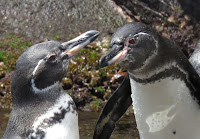 Our islands are blessed to be the indigenous home of the Galapagos Penguin. This is the only species of penguin that lives above the Equator. They are able to do so because of the cool water temperatures that result from the Cromwell Currents. There are “warm water” Humboldt penguins along the coasts of continental Ecuador, Chile and Peru, but they do not go north of the Equator.
Our islands are blessed to be the indigenous home of the Galapagos Penguin. This is the only species of penguin that lives above the Equator. They are able to do so because of the cool water temperatures that result from the Cromwell Currents. There are “warm water” Humboldt penguins along the coasts of continental Ecuador, Chile and Peru, but they do not go north of the Equator. Called a banded penguin, the Galapagos Penguin would never be physically mistaken for the more familiar Antarctic penguins. First, our penguins are much smaller, just about 19 inches tall and about 5 ½ pounds; females are even smaller. The Galapagos Penguin has a black head with a white border behind the eye, around the black ears and chin, to join on the throat. They are blackish-grey on top and white on their bellies, and have two black bands across their breast and extending down to their thigh. The Galapagos Penguin is the third smallest species of penguin.
While our penguins can be seen throughout the archipelago, 90-95% are found on Fernandina and Isabela Islands to the West. It’s on Isabela that they visit the northern hemisphere. Fortunately for me and my guests, as I guide, I’ve seen the penguins all over the archipelago. On two recent trips I saw penguins on Bartolome, one time a pair and the other about six standing in formation on the rocks near the water. (Some of the pictures on this blog are from Bartolome and provided courtesy of Aqua Surround.) We were especially lucky because there are believed to be only about 800 breeding pairs of Galapagos Penguins in the world so the population density outside of Fernandina and Isabela makes it very unique and even lucky to find them.
 |
| A Pair of Galapagos Penquins Which Mate for Life |
 |
| Galapagos Penguin Chick |
Our Galapagos Penguins tend to stay in the cool Pacific Water, fed by the Cromwell Current, during the day and return to the land at night. They feed on the multitude of small fish readily available near the shoreline, often sardines and mullet fish. Though they are clearly adapted to the hot sunshine, they do have to adjust their behavior to this equatorial environment. That explains why they stay in the water and close to the shore – so they can jump right in for a quick swim and cool down. On land, they also self-regulate their body temperature by keeping their feet out of the sun to prevent sunburned feet and by stretching out their flippers so that heat can escape through tiny arteries. They sometimes look comical in their movements when what they are actually doing is panting, using evaporation to cool the throat and airways.
The Galapagos Penquin is a valuable and extremely precious member of the Galapagos eco-system. As a naturalist guide, it always brings joy when we see these special creatures on our adventures throughout the archipelago.



No comments:
Post a Comment